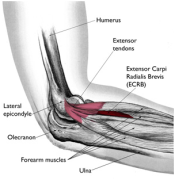Tennis elbow (lateral epicondylitis) resolves spontaneously in 80% of people. However, for the 20% that remain chronic, the condition is miserable and almost nothing in the literature shows benefit. In this 16 minute narrated video, 3 types of injections are discussed: PRP, hyaluronic acid and stem cells. Take a look at the future now.
We are currently conducting a study at Shaare Zedek Medical Center in Jerusalem. Call Bat-el to enroll: 025645503
DEFINITION & ANATOMY:
“Tennis elbow” is rarely caused by tennis! Tennis elbow refers to pain from inflammation at the outer part of the elbow. This is the site of attachment of muscles which bring the wrist upward (extension). Whether sports-related or work-related, it may be caused from overuse or from improper technique or equipment.
inflammation at the outer part of the elbow. This is the site of attachment of muscles which bring the wrist upward (extension). Whether sports-related or work-related, it may be caused from overuse or from improper technique or equipment.
Once the bone-muscle junction becomes irritated, even light activities such as opening doors and jars or even brushing teeth may be enough to cause pain and perpetuate the irritation. Treatment is aimed at reducing the inflammation and adjusting activities to avoid the irritation.
 One should be cautious to make sure the diagnosis is correct. Not all conditions that cause pain to the outside or lateral part of the elbow are from tennis elbow. Other conditions might include: radial tunnel syndrome, plica, radio-capitellar arthritis, instability and other more rare conditions.
One should be cautious to make sure the diagnosis is correct. Not all conditions that cause pain to the outside or lateral part of the elbow are from tennis elbow. Other conditions might include: radial tunnel syndrome, plica, radio-capitellar arthritis, instability and other more rare conditions.
CONSERVATIVE TREATMENT:
Treatment may begin with anti-inflammatory medication and simple avoidance of particular activities. Ice and/or heat may be helpful. Additionally, a strap is sometimes used across the muscle near the elbow. The strap will almost never cure the condition but it may reduce the pain and let someone continue to work or play sports. Formal therapy may be required if pain does not respond to these measures. This may include stretching, strengthening, and treatment such as ultrasound. If pain persists, an injection may be necessary. Research has shown that steroids provide only a short term benefit, up to 6 weeks. Recently, 2 other types of injections have shown more benefit. Usually, the body will eventually heal the problem on its own. Unfortunately, this can take up to a year and up to 20% of people will continue to have problems with pain.
In addition, people with neck and/or shoulder problems may develop tennis elbow secondarily. Therapy in that case is aimed at treatment higher up which will take the load off the elbow and allow it to heal.
Complementary Treatments:
Only a few studies have been published which scientifically evaluate complementary therapies. Acupuncture showed mild short term relief. Other treatments showing short term relief include ultrasound, low-energy laser, electrical therapy and massage.
Work modification:
Treatment should include avoiding forceful grasp or lifting with the palm in the down position (pronation). Vibratory tools should be avoided and gloves should not be used unless necessary since they require an increase in the force of grasp.
Tennis Players:
The following equipment changes may help the tennis player: increased racquet stiffness, larger racquet face, and looser grip with use of sticky or cushioned grip material. Stroke technique may include: early take-back of racquet in backhand to avoid late swing and effort to avoid slicing the ball .
SURGICAL TREATMENT:
Surgery may be required for the small percentage of people who continue to have significant pain despite these measures. This involves release of the muscle attachment and removal of scar tissue which then allows the muscle to heal and new healthy scar tissue to form. In addition, there are arthroscopic techniques that can be used for specific patients (if there is clicking or catching in addition to the tennis elbow). Recovery from this surgery often takes months and should be reserved for those who do not respond after months of effort to the measures described above.
To support research for tennis elbow, click HERE
